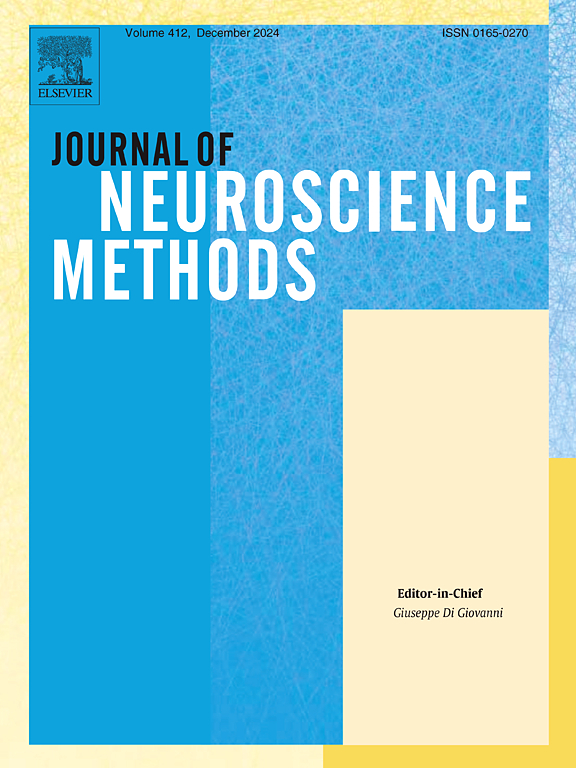一种新的脑结构和功能连接的整合,用于识别创伤性脑损伤引起的扰动
IF 2.7
4区 医学
Q2 BIOCHEMICAL RESEARCH METHODS
引用次数: 0
摘要
大脑执行具有固定结构的多种复杂任务的能力尚未得到充分阐明。结构连通性(SC)和功能连通性(FC)分别被越来越多地用于理解大脑的结构和功能。然而,有限数量的研究探索了这两个实体之间的关系,特别是在翻译动物模型中。我们提出SC和FC的整合可以提高对大脑结构、功能、它们之间的相互作用以及大脑对创伤性脑损伤(TBI)等神经系统疾病的反应的理解。我们在多个尺度(小尺度:皮质区域,中尺度:静息状态网络,大尺度:半球和全脑)上研究了结构-功能相关性,并采用贝叶斯框架将SC纳入构建结构知情FC (siFC)。结果健康猪SC与FC呈显著强相关(r = 0.277 ± 0.011),且在不同尺度上具有一致性。此外,siFC稳定性通过时间分辨fc之间的Pearson相关性(r = 0.72 ± 0.07)来测量。随后使用siFC的差分度测试分析提供了更明确的TBI引起的扰动谱。与现有方法相比,siFC比单独的FC更不受大的动态变化的影响。更准确地分析了由TBI引起的显著改变的连接和受影响的轮毂,这与TBI引起的结构变形一致。我们的研究结果表明,SC-FC整合模型改善了对脑连通性显著差异的检测,并精确定位了受TBI直接影响的中枢区域。本文章由计算机程序翻译,如有差异,请以英文原文为准。
A novel integration of brain structural and functional connectivity for identifying traumatic brain injury induced perturbations
Background
The ability of the brain to perform multiple complex tasks with fixed structures has yet to be fully elucidated. Structural connectivity (SC) and functional connectivity (FC) have been increasingly used to understand the structure and function of the brain respectively. However, a limited number of studies have explored the relationship between both entities especially in translational animal models.
New Method
We proposed an integration of both SC and FC can improve understanding of brain’s structure, function, their interplay, and brain’s response to neurological conditions such as traumatic brain injury (TBI). We investigated structure-function correlation at multiple scales (small: cortical regions, medium: resting state networks, and large: hemispheric and whole brain), and adapted a Bayesian framework to incorporate SC for constructing structurally-informed FC (siFC) using a translational porcine model.
Results
There is a significantly strong correlation r = 0.277 ± 0.011 between SC and FC in healthy pigs which is consistent across different scales. Further, siFC stability is measured as a Pearson correlation (r = 0.72 ± 0.07) between time-resolved FCs. Subsequent differential degree test analysis using siFC provided more explicit profiling of perturbations caused by TBI.
Comparing with Existing Methods
The siFC is more immune to large, dynamic variability than FC alone. A more accurate profiling of significantly altered connections and affected hubs by TBI is achieved which is consistent with TBI induced structural deformations.
Conclusion
Our findings demonstrated that SC-FC integration model improved detection of significant differences in brain connectivity and pinpoints hub regions that had been directly impacted by TBI.
求助全文
通过发布文献求助,成功后即可免费获取论文全文。
去求助
来源期刊

Journal of Neuroscience Methods
医学-神经科学
CiteScore
7.10
自引率
3.30%
发文量
226
审稿时长
52 days
期刊介绍:
The Journal of Neuroscience Methods publishes papers that describe new methods that are specifically for neuroscience research conducted in invertebrates, vertebrates or in man. Major methodological improvements or important refinements of established neuroscience methods are also considered for publication. The Journal''s Scope includes all aspects of contemporary neuroscience research, including anatomical, behavioural, biochemical, cellular, computational, molecular, invasive and non-invasive imaging, optogenetic, and physiological research investigations.
 求助内容:
求助内容: 应助结果提醒方式:
应助结果提醒方式:


